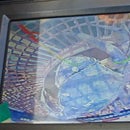Introduction: CrabCam Part Two: Transmitter Unit
In the last instructables we learned how to make the camera unit that will be attached inside the CrabCam. The images are transmitted up the cable to the transmitter unit inside the buoy. We'll look at the transmitting unit in more detail. It consists of a FPV transmitter, NRF24L01 transceiver, relay, arduino mini, and step down converter.
The idea is not to leave the transmitter on full time - it would quickly drain the batteries. The relay unit receives a command from the NRF24L01 transceiver to turn the transmitter and camera on or off.
Supplies
- 9 X 15 cm DIY Prototype PCB Universal prototyping Board $ 1.63
- (2)Waterproof DC12V Converter Step Down to 5V 3A 15W Power Supply Module $ 5.08
- 5V 1 channel Relay Module Shield Low Level for SCM DIY arduino $ 1.89
- 2PCS 2.4G NRF24L01+PA+LNA SMA Antenna Wireless $ 5.19
- 2X A83 NRF24L01+Wirelss Module with Breakout $ 2.27
- Wireless video transmitter and receiver - ideal for fpv drone quadopter $28.00
- 10pcs 20cm 4pin male to Female connectors $ 5.17
- 10pcs 20cm 2pin male to Female connectors $ 5.17
- 10pcs 5.5 2.1mm Female DC Power Plugs $ 2.96
- 10pcs 5.5.2.1mm Male DC Power Plugs $ 2.59
- 1 USB Nano V3.0 ATmega168 5V $ 3.92
- 10pcs 8 Pin Female tall stackble Header Connector Socket for Arduino Shield $ 1.98
- DC 12V 4800mah REchargeable Backup Portable Super li-ion battery $14.08
- 3" plastic jar
- Six inch piece of 2" ABS (black) pipe
- (2) end pieces 2" ABS pipe
- zip ties
- hookup wire
Step 1: The Non Copper Clad Side of the Perf Board
The transmitting unit is built on a 5 x 7 cm perf board that's copper clad on one side and plain on the other. The arduino mini is mounted on headers on the plain side with the header pins exposed on the copper side. I used wire wrap, but you can solder if you prefer. The NRF24L01 breakout is glued on that side as well. Because the NRF24L01 that plugs into the breakout unit hangs out in space and is likely to come loose I gluied a small piece of wooden dowel underneath it to support it. the waterproof down 12v to 5v is glued in the remaining space.
Step 2: The Copper Clad Side of the Perf Board
on The copper clad side the relay and the FPV video transmitter are glued. The remaining space is underneath the arduino on the other side and is kept open to allow wiring.
Step 3: Wiring the Transmitting Unit: the Concept
The concept behind the wiring:
The unit requires both 12 volts and 5 volts: 12 volts are required to run the FPV transmitter and the camera in the crab trap. The 12 volt supply is only required when one wants to turn the camera on and see what's in the trap - basically short bursts. Keeping it off will save battery time.
The five volt system is need to run the NRF24L01 transceiver(the receiving unit), the arduino mini, and the relay that turns on the 12 volt system.
I split the feed from the battery unit in two: one side feeds the step down converter (the 5 volt system) and the other feeds the twelve volt system routing through the relay.
Step 4: Connectors From the Transmitter
The only wires I used from the transmitter were the video (yellow) and the ground (black). I used a small four way connector. The connector had blue, green, yellow and red wires. The yellow from the transmitter connected to the green wire of the connector. Red wire to red wie on transmitter and 5v on relay and on to the battery connector. the blue wire to black wire on transmitter and black to black on transmitter and to battery connector.
On the arudino side of the board the positive 12v input of the step down converter goes to the red wire of the other battery connector (remember there are two) and the black wire from the connector to the ground input of the converter.
Step 5: Arduino Code for the Transmitter Relay
I owe the programming for the NRF24L01 relay control totally to Danny Vandenbrande. His instructable is at:
https://www.instructables.com/id/Arduino-NRF24L01-2...
A few notes to consider when using his project. I found it was sensitive to the version of arduino you use as well as VERY sensitive the library. If your getting errors - that's where it will be. For the record I'm using Arduino version:1.8.7 and the following library: Maniac library
Step 6: Battery
I wanted to use the larger black lead acid sealed unit for two reasons: it provided WAY more power than the smaller liithium-ion battery for two reasons: first of all it provided WAY more power, and secondly, because it was heavier and would provide ballast for buoy. Unfortunately the lead acid battery was 1/8" two wide to fit in the three inch ABS pipe, and I couldn't find any lead acid batteries that were smaller. The battery is rated at 4800mAh - although I think it's a lot less. Still it provided about 8 hours of underwater time. (not solid viewing, but mostly on standby and allowing quick looks into the trap every half hour or so). If you are going to use a larger lithium-ion battery make sure it will fit the pipe. Remember it's the inside diameter of the three inch pipe. About 2.65 inches - anything bigger won't fit. I would have gone for a 4" pipe - but they don't make it.











